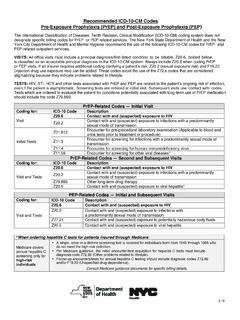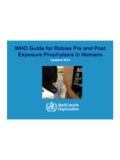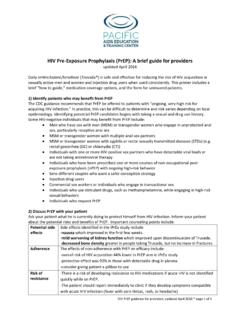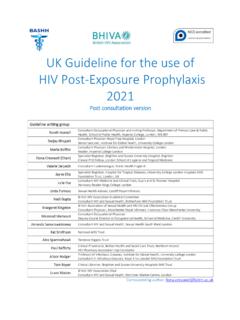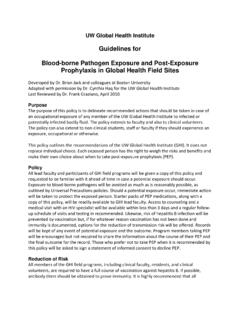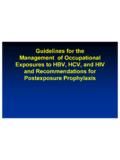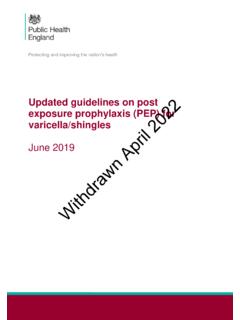Transcription of Blood/Body Fluid Exposure Option
1 Blood/Body Fluid Exposure Option Last Updated January 1, 2013 3-1 Blood/Body Fluid Exposure Option Introduction: Transmission of bloodborne pathogens [ , Hepatitis B virus (HBV), Hepatitis C virus (HBC), Human Immunodeficiency Virus (HIV)] from patients to healthcare workers ( HCW) is an important occupational hazard faced by healthcare personnel ( HCP). The risk of bloodborne pathogen transmission following occupational Exposure depends on a variety of factors that include s ource patient factors ( , titer of virus in the source patient s Blood/Body Fluid ), the type of injury and quantity of Blood/Body Fluid transferred to the HCW during the Exposure , and the HCW s immune status. The greatest risk of infection transmission is through percutaneous Exposure to infected blood.
2 Nevertheless, transmission of HBV, HCV, or HIV after mucous membrane or non-intact skin Exposure to blood has also been reported. The risk of transmission of these pathogens through mucocutaneous Exposure is considered lower than the risk associated with a percutaneous Exposure . An estimated 385,000 percutaneous injuries ( , needlesticks, cuts, punctures and other injuries with sharp objects) occur in hospitals each year. Prevention of occupational transmission of bloodborne pathogens requires a diversified approach to reduce blood contact and percutaneous injuries including improved engineering controls ( , safer medical devices), work practices ( , technique changes to reduce handling of sharps), and the use of personal protective equipment ( , impervious materials for barrier precautions).
3 Since 1991, when the Occupational Safety and Health Administration (OSHA) first issued its Bloodborne Pathogens Standard, the focus of regulatory and legislative activity has been on implementing a hierarchy of control measures. The federal Needlestick Safety and Prevention Act signed into law in November 2000 authorized OSHA s revision of its Bloodborne Pathogens Standard to more explicitly require the use of safety-engineered sharp devices. ( ). Other strategies to prevent infection include hepatitis B immunization and postexposure prophylaxis for HIV and HBV. Strategies for prevention of percutaneous injuries are addressed in CDC s Workbook for Designing, Implementing, and Evaluating a Sharps Injury Prevention Program at Facilities are not required to collect data for exposures that involve intact skin or exposures to body fluids that do not carry a risk of bloodborne pathogen transmission ( , feces, nasal secretions, saliva, sputum, sweat, tears, urine and vomitus) unless these are visibly contaminated with blood.
4 However, facilities that routinely collect data on such exposures may enter this information into the system. (i) Methodology Occupational exposures to blood and body fluids in healthcare settings have the potential to transmit HBV, HCV, or HIV. Use of the Blood/Body Fluid Exposure Option permits a Blood/Body Fluid Exposure Option Last Updated January 1, 2013 3-2 healthcare facility to record information about the Exposure and its management. This Option can be used in any healthcare setting where there is potential for occupational Exposure to blood and body fluids among HCP. This Option requires that data be entered into NHSN when exposures occur, as indicated in the Healthcare Personnel Safety Monthly Reporting Plan (CDC ).
5 In general, these data may be provided by the occupational health department in the facility or may be provided by the infection control/epidemiology department, as appropriate. NHSN forms should be used to collect all required data, using the definitions included for each data field. Blood/Body Fluid Exposure with or without Exposure Management A facility may choose to report Exposure events alone or Exposure events and subsequent management and follow-up of each event, including administration of postexposure prophylaxis (PEP) to the HCW and any laboratory test results collected as part of Exposure management. Settings: Any healthcare setting with the potential for occupational Exposure to blood and body fluids.
6 Requirements: B lood and body Fluid exposures are to be reported as they occur during the calendar year. Definitions: Bite: A human bite sustained by a HCW from a patient, other HCW, or visitor. Bloodborne pathogens: Pathogenic microorganisms that may be present in human blood and can cause disease in humans. These pathogens include, but are not limited to hepatitis B virus (HBV), hepatitis C virus (HCV) and human immunodeficiency virus (HIV). HCW (Healthcare Worker): A person who works in the facility, whether paid or unpaid, who has the potential for Exposure to infectious materials, including body substances, contaminated medical supplies and equipment, contaminated environmental surfaces, or contaminated air.
7 Healthcare worker is the singular form of healthcare personnel. HCP (Healthcare Personnel): A population of healthcare workers working in a healthcare setting. Hollow-bore needle: Needle ( , hypodermic needle, phlebotomy needle) with a lumen through which material ( , medication, blood) can flow. Mucous membrane Exposure : Contact of mucous membrane ( , eyes, nose, or mouth) with the fluids, tissues, or specimens listed below in "Occupational Exposure ." Non-intact skin: Areas of the skin that have been opened by cuts, abrasions, dermatitis, chapped skin, etc. Blood/Body Fluid Exposure Option Last Updated January 1, 2013 3-3 Non-intact skin Exposure : Contact of non-intact skin with the fluids, tissues, or specimens listed below in "Occupational Exposure .
8 " Non-Responder to Hepatitis B vaccine: A HCW who has received two series of hepatitis B vaccine is serotested within 2 months after the last dose of vaccine and does not have anti-HBs 10 mIU/mL. Occupational Exposure : Contact with blood, visibly bloody fluids, and other body fluids ( , semen, vaginal secretions, cerebrospinal Fluid , synovial Fluid , pleural Fluid , peritoneal Fluid , pericardial Fluid , and amniotic Fluid , tissues, and laboratory specimens that contain concentrated virus) to which Standard Precautions apply and during the performance of an HCW s duties. Modes of Exposure include percutaneous injuries, mucous membrane exposures, non-intact skin exposures, and bites. Percutaneous injury: An Exposure event occurring when a needle or other sharp object penetrates the skin.
9 This term is interchangeable with sharps injury. Sharp: Any object that can penetrate the skin including, but not limited to, needles, scalpels, broken glass, broken capillary tubes, and exposed ends of dental wires. Sharps Injury: An Exposure event occurring when any sharp object penetrates the skin. This term is interchangeable with percutaneous injury. Solid Sharp: A sharp object ( , suture needle, scalpel) that does not have a lumen through which material can flow. Reporting Instructions: Forms Description and Purpose: (See also: Tables of Instructions for Completion of Healthcare Personnel Safety Component forms) All NHSN facilities following the Blood/Body Fluids Exposure Option : For either Exposure reporting or Exposure and Exposure management reporting, a site should complete the following form: Healthcare Personnel Safety Component Facility Survey (CDC Form ) Used to collect facility administrative data including total patient beds set up and staffed, annual inpatient days, number of patient admissions per year, number of annual outpatient encounters, number of annual employee hours worked.
10 The survey also collects annual data on the total number of HCP in selected occupational groups (full-time equivalents and numbers of HCP, full or part-time). Healthcare Personnel Safety Monthly Reporting Plan (CDC Form ) Used to collect data on which modules and which months a facility intends to participate in Blood/Body Fluid Exposure Option Last Updated January 1, 2013 3-4 the NHSN HPS Component. This form should be completed for every month that the facility will participate in the HPS component. Exposure -Only Reporting: Those facilities participating in Exposure -only reporting should complete the following forms: Healthcare Worker Demographic Data (CDC Form ) Used to collect data on HCW demographics such as gender and occupation for a healthcare worker who has reported a blood or body Fluid Exposure .










